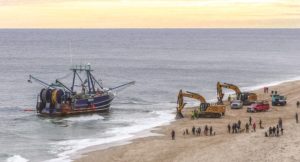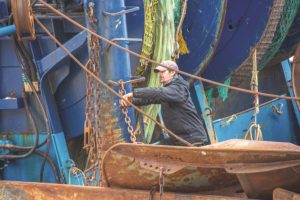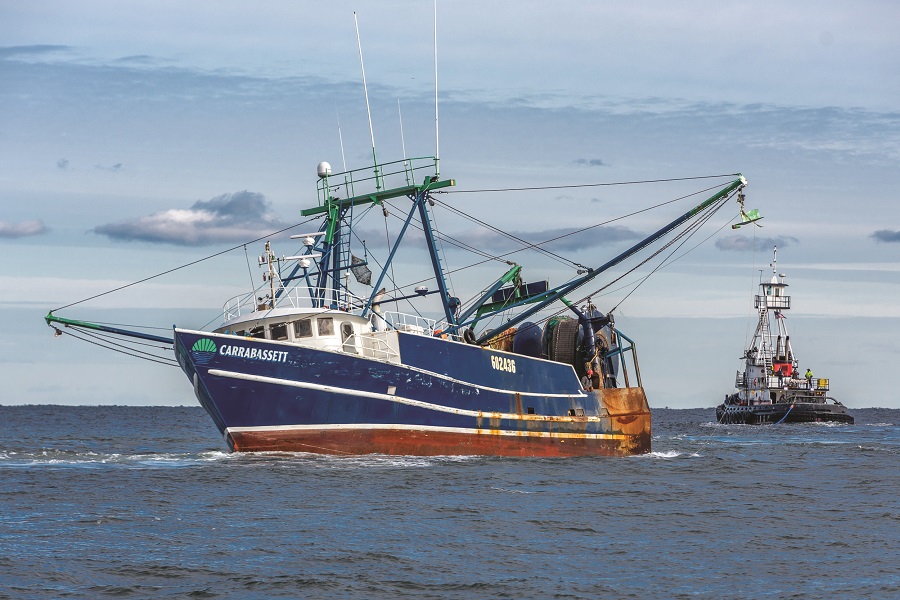TRURO — “There was a burst of spontaneous applause as the boat started to move,” said Brewster photographer and artist Steve Kennedy, who was among about 100 people at Longnook Beach on Saturday morning as the F/V Carrabassett was tugged back to sea.
Kennedy, formerly of Wellfleet, had been coming to the beach daily since the 78-foot groundfishing vessel ran aground on Tuesday, Nov. 30. Around him, a small crowd of visitors from as far away as Montreal chatted, sipped coffee, and watched the recovery.

The boat’s captain reportedly remained on board as its owners, the town, the National Seashore, and a local construction company worked to get the vessel legally and safely off the sand.
The Carrabassett was headed to Fairhaven, where a damage assessment will be done in the coming weeks, said Robert Vanasse of Stove Boat Communications, representing owner Blue Harvest Fisheries. “There were no leaks or environmental issues,” he added, a fact confirmed by the Coast Guard.
Blue Harvest hired Harwich excavator Robert B. Our to free the boat. But first, permits had to be obtained. Those came on Thursday and Friday from the town of Truro, the Seashore, and three neighboring private landowners, making it possible for Our’s equipment to get to the scene.

The town’s permit allowed the excavator to use the landing at Ballston Beach, and cost $25, according to Truro Town Manager Darrin Tangeman.
The Seashore issued a special use permit drawn up to reflect the specifics of the recovery. Its role, according to Supt. Brian Carlstrom, was to monitor and document the effort closely, being on the lookout for any environmental damage. As of Tuesday, Dec. 7, the cost of that permit and a calculation of Seashore staff time for the monitoring was still being determined, Carlstrom said. “Ship recovery is not something we do on a normal basis,” he said.
Describing the work, Carlstrom said that, first, excavation was done around the vessel so enough water could surround it to provide buoyancy. Then, working with the tide, a tugboat with a line attached to the vessel would help free it.

Mike Hallam, supervisor of Our’s marine division, said their work included “removing 6,000 gallons of fuel, for safety.” They also brought over two excavators and a tugboat from New Bedford. “We are going to restore the beach back to its natural state,” he said.
“The process requires a lot of paperwork: issues of insurance, a work plan, and a salvage plan,” said Hallam. As of Tuesday, Our’s bill was still being compiled.
Overall, things went well, Carlstrom said. “We were nervous about it because a number of things could have gone wrong, causing environmental concern,” he said. “Fortunately, that didn’t happen.”

The cause of the grounding remains under investigation, Vanasse said. Typically, an insurance company conducts a formal investigation following a claim to determine who is at fault and the appropriate course of action.
The 10 most common causes for boat accidents are operator error, operator inexperience, boating under the influence, violating navigation rules, lookout failures, speeding, equipment failure, weather conditions, waves or wakes, and hazardous water conditions, according to the independent accident resource firm Enjuris.
Back at Longnook Beach, Kennedy, who lived on the Outer Cape for nearly 40 years, said he’s seen boats run ashore just three or four times. He recalled when the Eldia, a 451-foot steel freighter, was blown ashore at Nauset Beach in Orleans during a nor’easter in 1984. The crew had to be rescued by helicopter and the excavation happened over seven weeks, drawing spectators from around the country.
Montreal natives André Guimond and Lucie Thibault described how they watched starting at 7 a.m. on Saturday as cranes worked on the excavation. “It was very impressive,” Thibault said. She said she read about the boat in a Montreal newspaper. “We made sure to take a picture, to say, ‘We were there.’ ”
Guimond and Thibault took a break, heading to Guimond’s home on Long Nook Road to warm up. The two returned to the beach at 10:30 to watch the boat take off, but it was too late.
Other curious onlookers raced from the parking lot to the shore. “It’s gone?” they asked.
A group of about 20 latecomers were welcomed as the crowd watched the Carrabassett grow smaller in the distance.



